Knapweed Feeds Bees
If bees could open a restaurants, I'm quite sure common knapweed - Centaurea nigra would be at the top of the menu. Why? Quite frankly, it is visited by so many species including solitary and bumble bees as well as honey bees - not to mention other pollinators.
Knapweed is rich in nectar, and flowers over a long period - it can be seen from June through to September. It's a great boon to wildlife generally, since the seeds are eaten by birds.
Although the head looks a little like a thistle, it's not a prickly plant. The leaves and stems are slender and smooth rather than covered in small, prickly spikes.
Below is a photograph of a wild verge around the corner from my house. It provides excellent sources of food (and nest sites) for bees. Included in the bounty are thistles, bramble, dandelions, clover, and hemp agrimony among others. In the summer time, I can rely on this little patch to provide some good opportunities to take photographs of bees.
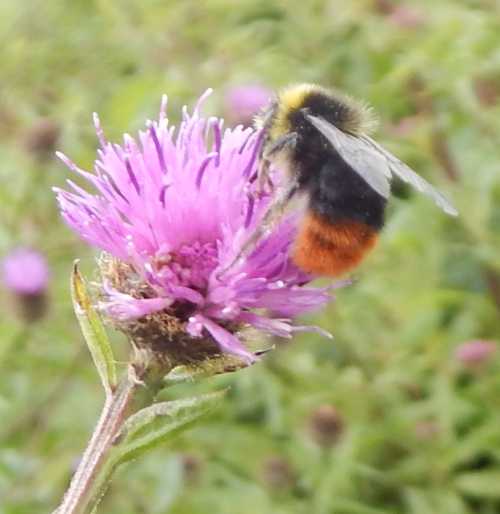 Red-tailed bumble bee - Bombus lapidarius - male foraging on knapweed.
Red-tailed bumble bee - Bombus lapidarius - male foraging on knapweed.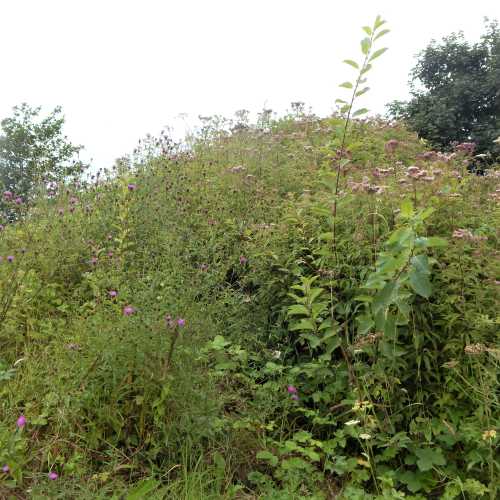 Knapweed and hemp agrimony make this ideal habitat for bees and other pollinators. Other food sources include bramble, thistle, clover, daisies, dandelion, and various umbellifers.
Knapweed and hemp agrimony make this ideal habitat for bees and other pollinators. Other food sources include bramble, thistle, clover, daisies, dandelion, and various umbellifers.Knapweed is a wildflower I would experiment with planting into my garden border if my garden was large enough. I don't include it in my garden at the moment, however, since I reckon that because there is so much knapweed in my immediate surrounding location, the bees are fairly well catered for with knapweed - a bit like dandelions.
Instead, having a small garden, I prefer to focus on including flowers to attract particular species - such as pulmonaria for hairy footed flower bees, and lamb's ear for wool carder bees. As a result, I believe I am seeing increases in numbers of these species every year, with more females emerging than in previous years.
However, if anyone is involved in a project to create wildflower verges for bees and other pollinators, then knapweed would be on the 'must have' list of flowers to include.
More pictures of bees on knapweed:
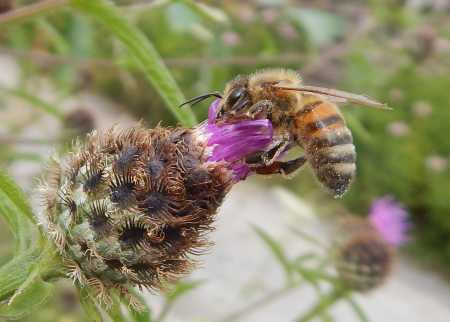 Knapweed is popular with honey bees (Apis mellifera).
Knapweed is popular with honey bees (Apis mellifera).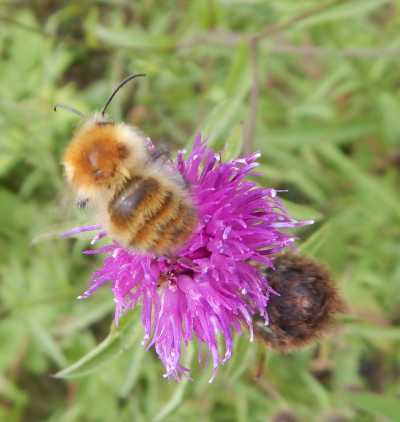 Brown banded carder bees Bombus humilis like knapweed too!
Brown banded carder bees Bombus humilis like knapweed too!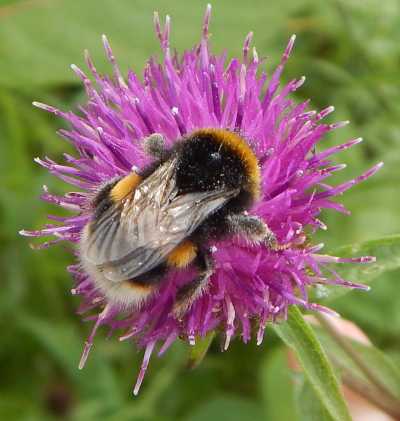 White tailed bumble bee -Bombus lucorum - queen, foraging on knapweed
White tailed bumble bee -Bombus lucorum - queen, foraging on knapweedMore articles about bees and plants
- Bees Foraging On Eryngium (Sea Holly) Eryngium: A magnet for bumble bees, honey bees and various solitary species. It is fairly hardy.
- Bees & Poppies Bees love foraging on poppies for pollen - especially the Opium Poppy - Papaver somniferum
- Pulmonaria Officinalis - A Wonderful Early Flowering Plant For Bees Pulmonaria Officinalis attracts bumblebees and hairy footed flower bees and is easy to grow
- Bees love lupins – but so do slugs and snails, so what can you do? Bees love lupins – but so do slugs and snails, so what can you do? Here's a way to protect your lupins....using garlic!
- Bees And Bee Balm Bee Balm (Monarda) - also known as 'Bergamot) is a herbaceous perennial which is attractive for bees.
If you found this page helpful or interesting, I'd really be grateful if you would share it with others - if not this page, perhaps another, such as Gardening For Bees.
Thank you so much :) .